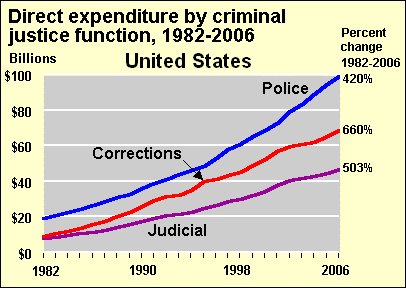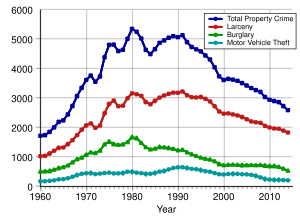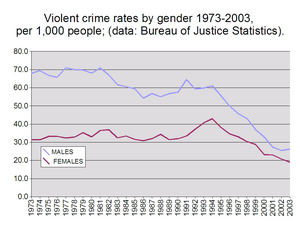Incarceration in the United States
[17] In the 18th century, English philanthropists began to focus on the reform of convicted criminals in prison, whom they believed needed a chance to become morally pure to stop or slow crime.These jails served a variety of functions, such as a holding place for debtors, prisoners-of-war, and political prisoners, those bound in the penal transportation and slavery systems; and those accused but not tried for crimes.[24] Late in the 1800s, Superintendent Zebulon Brockway also changed the landscape of prison life by introducing institutionalized learning programs to inmates for rehabilitation purposes at the Elmira Reformatory in New York.Because of discriminatory practices and limited access to resources, transgender adults are also more likely to engage in criminal activities to be able to pay for housing, health care, and other basic needs.[88][91] Human Rights Watch also claims that corrections officers routinely use excessive violence against mentally ill inmates for nonthreatening behaviors related to schizophrenia or bipolar disorder.The criteria used by the World Health Organization that if the substance has the capacity to produce a state of dependence, and central nervous system stimulation or depression that results in hallucinations or disturbances in motor function or thinking or behavior or perception or mood.[124][125] This resulted in the restoral of federal Pell Grant funding for Prison Education Programs (PEP) and legislation like California bill SB416 that protects incarcerated students from predatory lending.The number of incarcerated individuals in U.S. jails and prisons jumped 500% in the three decades following the implementation of tougher sentencing laws associated with the War on Drugs and the "tough on crime" movement.[36] Juvenile correctional facilities are operated by local authorities or the state and serve as longer-term placements for youth who have been adjudicated as delinquent and ordered by a judge to be confined.Florence is considered to be of a security level above that of all other prisons in the United States, at least in the "ideological" ultramax part of it, which features permanent, 24-hour solitary confinement with rare human contacts or opportunity to earn better conditions through good behavior.[167] The non-governmental organization Human Rights Watch claims that prisoners and detainees face "abusive, degrading and dangerous" conditions within local, state and federal facilities, including those operated by for-profit contractors.In California, the inadequate security engendered by this situation, coupled with insufficient staffing levels, have led to increased violence and a prison health system that causes one death a week.[211] According to journalist Matt Taibbi, major investors in the prison industry include Wells Fargo, Bank of America, Fidelity Investments, General Electric and The Vanguard Group.In September 2016, large, coordinated prison strikes took place in 11 states, with inmates claiming they are subjected to poor sanitary conditions and jobs that amount to forced labor and modern day slavery.Yale Law Professor, and opponent of mass incarceration James Forman Jr. has countered that 1) African Americans, as represented by such cities as the District of Columbia, have generally supported tough on crime policies.[303] Even while adjusting for various socioeconomic and racial factors, children with an incarcerated parent have a significantly higher chance of developing a wide variety of physical problems such as obesity, asthma, and developmental delays.[310] In a specific case study in Boston by Sack, within two months of the father being arrested, the adolescent boy in the family developed severe aggressive and antisocial behaviors.[315] Based on analysis of the 2002-4 Survey of Inmates in Local Jails, incarcerated individuals had higher rates of hypertension, diabetes, myocardial infarction, asthma, arthritis, cervical cancer, and hepatitis.A law passed in Oklahoma in 2014 requires judges to inquire if convicted individuals are single custodial parents, and if so, to authorize the mobility of important resources so the child's transition to different circumstances is monitored.[357][358] "Human Rights Watch believes the extraordinary rate of incarceration in the United States wreaks havoc on individuals, families and communities, and saps the strength of the nation as a whole.[360] The scholars Michael Meranze and Marie Gottschalk contend that the massive "carceral state" extends far beyond prisons, and distorts democracy, degrades society, and obstructs meaningful discourse on criminal punishment.[199][211][363][364][365][366] Sociologist Loïc Wacquant argues that the "explosive growth" of the incarcerated poor can be seen as part of the "punitive regulation" of poverty in the neoliberal era to mitigate societal fallout from economic deregulation, welfare state retrenchment, increasing inequality and the imposition of workfare and underpaid, precarious employment on the marginalized urban "postindustrial proletariat".[368] Professor of Law at Columbia University Bernard Harcourt contends that neoliberalism holds the state as incompetent when it comes to economic regulation but proficient at policing and punishing, and that this paradox has resulted in the expansion of penal confinement.On December 21, U.S. District Court Judge Myron Thompson ruled in a lawsuit brought by the American Civil Liberties Union (ACLU) on behalf of several inmates that Alabama's practice in doing so violated federal disabilities law.[378] On August 12, 2013, at the American Bar Association's House of Delegates meeting, Attorney General Eric Holder announced the "Smart on Crime" program, which is "a sweeping initiative by the Justice Department that in effect renounces several decades of tough-on-crime anti-drug legislation and policies.Artists like Tupac Shakur, NWA, LL Cool J, and Kendrick Lamar have written songs and poems that condemn racial disparities in the criminal justice system, specifically the alleged practice of police officers targeting African Americans.[382] The soul singer Raphael Saadiq's 2019 album, Jimmy Lee, thematizes racial disparities in mass incarceration as well as other societal and family issues affecting African Americans.For example, Ava DuVernay's Netflix film 13th, released in 2017, criticizes mass incarceration and compares it to the history of slavery throughout the United States, beginning with the provision of the 13th Amendment that allows for involuntary servitude "as a punishment for crime whereof the party shall have been duly convicted".#BlackLivesMatter, a progressive movement created by Alicia Garza after the death of Trayvon Martin, was designed as an online platform to fight against anti-Black sentiments such as mass incarceration, police brutality, and ingrained racism within modern society.This movement has focused on specific racial issues faced by African Americans in the justice system including police brutality, ending capital punishment, and eliminating "the criminalization and dehumanization of Black youth across all areas of society.















United States incarceration rateComparison of United States incarceration rate with other countriescrime in the United Statesincarceratedfewer persons in prisonWorld Prison Briefdebtor's prisonsVera Institute of JusticeHistory of United States prison systemsQuakersscripturesrepentElam LyndsAuburn State PrisonAuburn SystemDorothea DixinhumaneZebulon BrockwayElmira ReformatoryCivil WarProgressive Era of Americaindeterminate sentencingprobationracial capitalismslave laborretributiveSicilian Americansrehabilitation.Richard NixonWar on Drugspresidency of Ronald ReaganComprehensive Crime Control Act of 1984mandatory minimum sentencesAnti-Drug Abuse Act of 1986bipartisanValerie JennessList of U.S. states by incarceration and correctional supervision rateRace and crime in the United StatesRacial inequality in the American criminal justice systemIncarceration of women in the United Statesrecreational drugsAngela DavisHispanic Americanwhite womenWashington PostYouth incarceration in the United Statesjuvenile courtscriminal justiceUnited Nations Human Rights Committeelife imprisonmentprivate facilitiesPrison Policy InitiativeSchool-to-prison pipelinezero-tolerance policiessuspensionelderly prisonersMiddle Tennessee State Universitylife sentenceMedicareMedicaidAmerican Civil Liberties UnionLGBT people in prisonNational Center for Transgender Equalityhomelessnessprofilinggender non-conformingLGBT people in jail and prisonsolitary confinementMentally ill people in United States jails and prisonsmental illnessdeinstitutionalizationBureau of Justice StatisticsHuman Rights Watchpsychotropic medicationschizophreniabipolar disorderrecidivismdiversion programsmental health courtsassertive community treatmentcase managementindividualsImmigration detention in the United StatesCustoms and Border ProtectionImmigration and Customs Enforcementpoor in the United StatesPhilip AlstonMatthew DesmondPrinceton UniversityCriminal sentencing in the United StatesDeterminate sentencingmandatory minimumsguidelines-based sentencingmitigating or extenuating circumstancesthree strikes lawsViolent Crime Control and Law Enforcement ActUnited States Department of Justicedrug offendersLen BiasdecarcerationPrison educationvocational educationPell GrantRAND CorporationRecidivism in the United StatesList of countries by incarceration rateEngland and WalesGreeceNorwayNetherlandsThe Times-PicayuneNew York TimesSoviet UnionSoviet Union's populationAnne ApplebaumSteven RosefieldeThe New YorkerAdam GopnikStalinLists of United States state prisonscorrections officersBureau of PrisonsSecurity Housing UnitsupermaxSupermax prisonprison gang